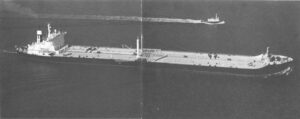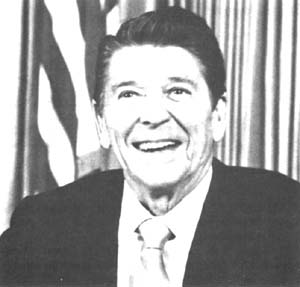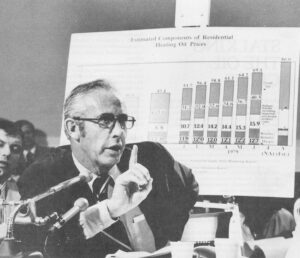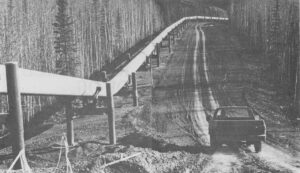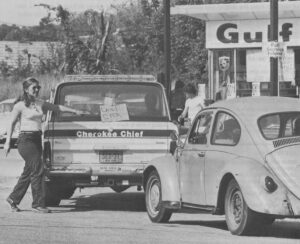WASHINGTON, DC–While the Reagan administration’s deregulation blitz continues, a paradox has emerged on the question of how the U.S. government will handle the next oil crisis. As things stand now, two seemingly contradictory strategies are in place.
Predictably enough, the administration is planning a purely free market, hands-off approach to the issue of how oil products will be distributed within the U.S. during a crisis. A recent policy paper says that domestic petroleum prices will be allowed to rise to whatever the traffic will bear during a crisis, and consumers’ ability to pay the higher prices will be the only thing that determines who gets how much gasoline and heating oil.
But at the same time, the administration has announced its support for an international organization whose main feature is a cumbersome and uncertain regulatory scheme to control the international oil market during a severe crisis. This plan, the emergency oil sharing plan of the International Energy Agency (IEA), is replete with complicated regulations, government intervention, constraints on companies’ actions–just about everything, in other words, that free market advocates abhor. In addition, the plan would require the U. S. to give up a greater proportional share of oil imports in most crises than many allies. And according to an internal Energy Department report, federal officials doubt that the plan, which has never been used, would work in a real emergency.
Why is the Reagan administration simultaneously backing two seemingly contradictory approaches to oil crises? The answer, some officials say privately, is that Reagan inherited a tradition of U.S. support for the IEA and believes that to withdraw the U.S. commitment would outrage allies. “Ideally we would like to pull out,” one official said. “But the political flak from overseas would be unbearable.”
That leaves the IEA sharing plan as the Western world’s main weapon for the next crisis, aside from individual countries’ reserve oil stocks. The IEA is a 21-nation body, including the U.S. and most other Western industrial nations, that was set up after the 1973-74 Arab oil embargo to deal with oil crises and encourage international cooperation in energy.
The oil sharing plan would be triggered in an oil shortfall of 7 percent or more unless 15 member countries voted to block the plan.
The plan’s mathematical formula favors countries that import a larger proportion of their oil than the U.S. For instance, in a shortfall of 4.2 million barrels a day, representing 12 percent of oil consumption in IEA countries, the U.S. would lose about a quarter of its oil imports, about twice as much as Japan or Germany would lose. Despite this, the U.S. has supported the IEA-and, in fact, was the prime mover in creating it–because a formal oil sharing plan among the importing nations helps prevent the OPEC cartel from singling out a country for a selective embargo and because of the goal of international cooperation in energy.
Virtues of Uncontrol
The administration’s plans for dealing with future crises are likely to provoke a struggle in Congress this fall. The Emergency Petroleum Allocation Act, which gave the federal government authority to allocate domestic petroleum supplies in a crisis, expires at the end of September, and the administration has told Congress that it doesn’t want any new allocation law enacted. That means, for one thing, that the government would be giving up its traditional role as the protector of the independent sector of the oil marketplace. Also, it means that the government would do nothing to relieve any particularly severe regional shortages that might develop. Already, half a dozen bills have been introduced to preserve some form of federal allocation authority, and some senior Republican senators are likely to break with the administration’s position.
In a position paper issued with little fanfare in July, the administration said that an uncontrolled domestic marketplace is the best allocator of scarce petroleum supplies during a crisis. “Gasoline and distillate [diesel and heating oil] prices could reach peaks of somewhat more than $3.00 per gallon in the U.S. market…” the paper says, adding that “prices will be allowed to rise and the government will not allocate supplies during disruptions.”
The paper contends that “conservation, fuel switching and domestic oil production will be maximized as millions of individuals and firms respond to rising oil prices. These decisions can best be made on a decentralized basis at the grass roots level by the millions of consumers and producers who are most knowledgeable about their own circumstances and the alternatives available.
Balancing Oil Out
“Individual decisions by producers and distributors in response to changing relative prices will also provide the most rapid and effective response to any shortages that may develop in a region due to a disproportionate loss in supplies by refiners that serve the region or if such refiners give up oil under the [IEA] sharing agreement. While existing contracts between suppliers and their customers may cause some stickiness in the responsiveness of the market, higher prices in one region will quickly bid away crude and product from other regions to balance the burden. These adjustments will be made more rapidly and efficiently in response to price signals than under price controls and allocation…”
What will the OPEC cartel do while Americans bid against each other for oil products? The paper does not address that question, but the precedents of the 1979 crisis are not reassuring. During that crisis, OPEC was not a price leader. Every time OPEC raised its prices, they were increased to a level that had already been reached in the spot market as consuming nations and companies competed for oil. The free market led, OPEC followed, and the spot market price became the permanent price.
Bart House, DOE’s acting assistant secretary for emergency preparedness, said the administration is confident that its free market approach to domestic allocation won’t encourage a repeat of the 1979 pattern. “At the beginning of a crisis, there will certainly be an incentive for the price to shoot up,” House said, “But once the shortage is over, it will come right back down again. The prices we have now are all the market can take. We don’t think you’ll see the ratchet effect we’ve seen in the past.”
The Paper Chase
During an international oil supply crisis, the first step in triggering the IEA sharing plan is a finding by the agency’s professional staff, called the Secretariat, that supplies are short by 7 percent or more. The IEA gets detailed reports on world oil supplies, both from member governments and from 47 companies. Then, unless the use of the plan is vetoed by 15 or more member nations, the IEA would summon an advisory committee of industry officials to its headquarters in Paris. The Secretariat would use its complex formulas to calculate each country’s right to receive oil from the international supply pool, or their obligation to divert oil to other, more needy countries.
With assistance from the industry experts, the Secretariat would then try to supervise a major portion of the world oil market. Since the U.S. has much more domestic oil production than other IEA countries, its share of oil available for imports would be lower. As the General Accounting Office noted in a recent report, the U.S. “stands to lose oil under most IEA shortage scenarios.”
Last fall, the IEA tested the system for the third time since it was created in 1974. Although no oil was actually diverted from normal market channels, the oil executives gathered in Paris, the Secretariat provided statistics on a hypothetical supply disruption, and the agency, working with the oil men, carried out a paper exercise in rearranging the Western world’s remaining supplies. In an internal report, DOE officials who took part said so many things went wrong that they had “serious reservations that the existing IEA oil-sharing system would function effectively in an emergency. These reservations stem from experiences in the test and our real world involvement in energy emergencies.”
They cited three serious problems. IEA data, they said, is not accurate enough. Cooperation between U.S. companies and the U.S. government is hampered by unresolved antitrust questions. And, probably most important, the IEA sharing system fails to deal with the vital question of price. Although the IEA claims the authority to order companies to sell oil, the price is left to negotiations between the parties. In a real crisis, companies could thwart IEA allocation orders by demanding a price that buyers were unwilling to pay.
Rhetoric and Reality
“The IEA system depends upon IEA’s ability to calculate allocation obligations and rights based on data submitted by companies of member countries. In a real emergency, the credibility of the system would depend on member countries believing in and agreeing to those calculations,” the DOE report said. The test, it said, “demonstrated that the data systems are not sufficient for this to occur. Oil was ‘lost’ from the system. International flows could not be balanced. During the test, the IEA secretariat resolved these discrepancies on a best guess basis. Some of these resolutions involved arbitrary decisions about substantial volumes of oil…The problems would be more severe in a real emergency.” For instance, companies diverted too much oil from the East Coast to the West Coast during the test, leaving Florida with a hypothetical 17 percent gasoline shortage and California with a 61 percent surplus.
IEA’s main goal, cooperation among the consuming nations, has had mixed results at best. In crises such as the one in 1979, when the shortfall in world supplies does not reach 7 percent, the IEA has no official powers to control the distribution of oil. So in March, 1979, the IEA countries voted to cut oil demand by 5 percent as their main strategy for coping with the crisis. But the details of which country would do what remained vague. Stuart Eizenstat, chief domestic policy advisor to President Carter, said in an interview that Germany, which has a free market approach to oil, thwarted a U.S. plan calling for specific conservation actions by each country. “We felt the Germans didn’t fully appreciate the problem of the shortage and that their philosophy, which was let the market work and we’ll buy our way out, was one that simply wouldn’t work very well and that there needed to be some allied cooperation.”
However, classified IEA oil supply figures, which give the first detailed breakdown of how individual countries fared in the 1979 scramble for oil, show that the U.S. lost out badly to allies such as Japan which bought heavily on the world spot market while the U.S. was trying to discourage spot market buying. High prices on the spot market, where cargoes of oil not under contract are sold to the highest bidder, influenced OPEC to raise its prices several times in 1979, according to many analysts. “The panic in the West, reflected in the spot market, was as much responsible for the price run-up as anything OPEC did,” Eizenstat said.
IEA documents also show that the U.S. was one of only a few IEA countries that actually complied with the organization’s call for a 5 percent cut in oil consumption to reduce the impact of the crisis. Canada, Japan, Italy and the United Kingdom were among the countries showing higher consumption.
With the U. S. more strongly committed to the conservation strategy than key allies, some Congressional critics, such as Senator Howard Metzenbaum (D-Ohio). began voicing suspicions that the U.S. was bearing a disproportionate share of the shortage.
Administration officials admitted there was such a problem, but they portrayed it as minor. On June 12, 1979, Deputy Energy Secretary John O’Leary told a House subcommittee that “prior to the crisis we were getting about 36 percent of world crude supply. At the lowest point, which occurred in March or April, we then were getting 35 percent of the internationally traded supply of crude. We were back up to about 36 percent by May. That indicated we were able to hold our proportion.”
The IEA supply figures, however, show a different picture. The statistics were collected by each member government from oil companies operating in its jurisdiction. The figures are considered more accurate than the IEA data used in last fall’s test. But other IEA documents say that the figures submitted by Germany apparently were too low and that Germany actually got more oil. The figures compare each country’s 1979 supplies to its normal oil consumption levels before the crisis. The U.S. was the only IEA country with a steady pattern of reduced supplies for the first nine months of the year.
Oil crisis management isn’t discussed much in Congress, except when a crisis arrives. Metzenbaum is the only member of Congress who has ever insisted on his right to attend closed IEA meetings. He said that both the administration’s free-market approach and the relationship of the IEA to U.S. interests deserve more congressional attention than they have gotten. As for the free market, he said, “you just don’t have normal market forces at play in the oil industry.” And as an IEA member, the U.S. seems to lose out whether the system works well or works badly. Metzenbaum said, “I don’t think IEA really ever picked up on its original purpose of being a counter-force to OPEC,” he said. “It made for good conversation at the time, but so far it’s never come to pass.”
World Oil Suplies During the 1979 Oil Crisis | |||
| January-March | April-June | July-September | |
| United States | -2% | -6% | -2% |
| Japan | +9 | +5 | +4 |
| Germany | -1 | -1 | +2 |
| United Kingdon | +1 | +1 | +1 |
| Italy | -1 | -7 | +4 |
| Canada | +4 | +1 | +9 |
| New Zealand | +8 | -4 | +11 |
| Austria | +10 | +2 | +9 |
| Ireland | +14 | +6 | -7 |
| Sweden | -8 | +6 | +13 |
©1981 Brian Donovan
Brian Donovan, a reporter on leave from Long Island’s Newsday, is investigating U.S. petroleum policies.

